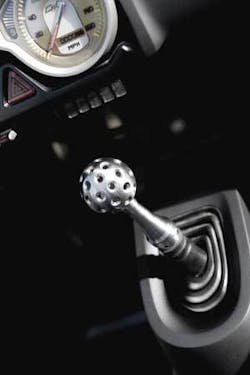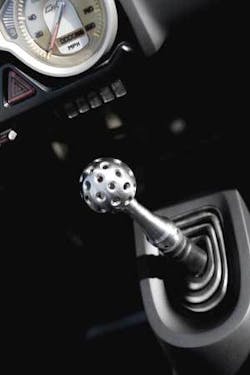RP shifts into gear
Los Angeles, CA - Volkswagen recently premiered the GX3 concept vehicle, a three-wheel, two-seat crossover between a sports car and a motorcycle. As would be expected, nothing about the GX3 is ordinary, even down to the stainless-steel shifter knob that VW calls its “center jewel.”
As the GX3 design was taking shape the design team decided they wanted something extraordinary, a modern twist on VW’s Golf GTI golf ball-shaped shifter knob. They conceived a hollow, lightweight appearance that retained the GTI shape, with a metallic finish that matched the vehicle trim and accents.
To accomplish this, the team turned to Direct Metal Laser Sintering (DMLS) from EOS (www.eos.info) whose EOSINT M270 system could produce the product they wanted using rapid manufacturing techniques.
Volkswagon took the EOS-produced 17-4 stainless steel, shot peened finished shifter knob, and turned it on a lathe to produce the machined finish that matches other cockpit components, and tapped a hole for the set screw. According to VW America Chief Designer Derek Jenkins, “I was amazed at how well it machined. It was fully dense with the properties of billet material. Without this technology, our designs were constrained, even limited, by what traditional manufacturing technologies could produce.” He also commented that, “With this technology (DMLS), will anyone be injection molding parts ten years from now.”
Jenkins predicts that industry is moving toward e-Manufacturing, the fast, flexible, and cost-efficient production directly from CAD data. Citing the evolution of rapid prototyping from exotic and expensive to a standard part of the design process, he foresees and awaits the same developments in e-Manufacturing. “I believe that the technology will progress from a prototyping tool to a manufacturing process. This is the future of manufacturing.”
VW is planning on an extensive accessory program in which they will offer the DMLS shifter knobs in stainless steel, titanium, or any other material that EOS has available. Any decision to make the GX3 will depend on market response, however the Los Angeles reception was positive and it is possible that production on the crossover vehicle could begin next year.
For more information on the EOS process, contact Jim Fendrick at [email protected].
Micro-welding plastic
Sarnen, Switzerland - Plastics are playing an ever-increasing role in micro-technology, especially in low-cost, mass-produced applications. Plastics like polymethylmethacrylate (PMMA), polycarbonate (PC), and cyclopolyolefinpolymere (COC) have been intensively investigated because of their resistance to certain chemicals and their biocompatibility. While laser welding of plastics was developed in the 1960s, it has only recently become a cost-effective technology offering the advantages of non-contact and localized energy input by laser beam. Traditional joining procedures for plastic parts include glue cured by heat or UV light, ultrasonic welding, and hot gas welding. However, most of these methods cannot easily be adapted to micro-structured plastic parts due either to adhesive dispensing problems and the chemical and surface properties of the adhesives or, with the latter methods, the generation of particulates and the lower precision of energy transfer.
Recent progress in semiconductor laser technology coupled with the development of compact, economical, and reliable laser sources in the near infrared range (700 to 1500 nm) have promoted the use of laser welding as an effective and viable alternative for joining micro-fluidic devices. The new Novolas Micro laser system, from Leister Process Technologies (Sarnen, Switzerland; www.leister.com) is used for welding plastic-to-plastic micro-fluidic devices. It uses a patented mask (laser stencil) method whereby a mask is inserted between the laser source and the parts to be welded. A curtain or collimated laser beam is moved across the entire joining area of the parts. The laser beam is only incident on the components where they are not obscured by the mask. The mask makes it possible to project extremely fine structures in the order of microns.
Mask welding uses the same transmission welding principles as the contour (a laser spot is guided sequentially along a predetermined welding pattern, melting it locally) and simultaneous (one or more lasers heat the entire weld path simultaneously) methods. It also requires the same externally applied clamping pressure. Like simultaneous welding, mask welding also uses a laser line to produce a weld. Mask welding differs from the simultaneous process in that it incorporates the use of a mask to block the transmission of the laser line as the line is scanned over a part. The mask shape determines the pattern of weld produced, and its precision is significant in determining the accuracy of the final weld. A precise mask is produced via photolithographic removal of predetermined portions of a metallic coated glass, producing a fine pattern. The pattern can be as varied as required by the application.
The mask is accurately positioned over the parts to be welded and the clamping fixture. The laser line is then scanned over the mask. The mask acts to selectively block the laser light from entering into the part. Where the laser light is allowed to enter, welding is achieved. Using the mask welding process, it is possible to produce an area of weld instead of just a line of weld.
The main advantage of this process is that is allows for very precise and very fine weld lines. Weld lines as narrow as 100 μm have been successfully made with the mask welding process. In addition, this process enables the possibility of producing welds with elaborate structures or contours. During one weld sequence, it is plausible to weld lines with different widths and shapes, as well as whole areas of weld.
One company currently is using the mask welding system in a micro-fluidic cartridge used for a biosensor application. The material combination is a clear 40-micron polycarbonate film welded/bonded on top of a black polycarbonate cartridge base approximately 2- x 3-inches with molded micro-channels.
The Novolas Micro is a standalone, turnkey system with manual in, manual out loading. It is equipped with a positioning system that detects fiducials designed into the part and precisely aligns the part for mask welding over the various micro-channels.
For more information, contact Bill Miller at [email protected].
Coding hot glass
Harlow, UK-Renowned glass bottle manufacturer O-I (formerly Owens Illinois) has installed equipment here that enables laser coding directly on the bottle while the glass is still hot. The company, which is a supplier to all of the UK’s top five breweries and many of the country’s leading regional producers, uses the technology to enable identifying faulty batches, distinguish between suppliers where customers source bottles from multiple locations, and protect against counterfeiting.
“We desired a durable coding solution that could withstand the rigors of being handled through the filling and distribution process. If the text is damaged or removed, it is ineffectual for purposes of traceability or authenticity,” says Mark Eldrett, quality assurance manager of O-I.
Linx Printing Technologies (Cambridge, UK; www.linxglobal.com) recommended the use of its ‘hot glass coding’ laser solution, which applies the code close to the point at which the bottle or jar is formed, while the glass is still red hot. This process generates a ‘clean,’ smooth mark that is less visible and thus more discreet than codes created on cold glass.
Linx’s Xymark BBH reportedly is specially adapted to suit the extreme conditions found in glass manufacturing plants. To ensure an effective code, the laser optics are designed to tolerate a long lens-to-product distance and have sufficient depth of focus to deal with slight inconsistencies in the alignment of the bottles as they travel down the line. The extra-long beam delivery system, comprising flexible arm and print head, can withstand ambient temperatures up to 70 degrees C.
The coder itself is designed to be mounted on a pedestal beside the production line for installations where space is an issue. It has a special cooling system allowing it to operate at temperatures up to 50 degrees C. The system also features a remote keyboard to allow the system to be programmed, adjusted, and controlled remotely.
O-I has installed the Xymark BBH on six high-speed production lines at its Harlow glass plant. Each is programmed to apply a single-line alphanumeric code at 50 meters per minute indelibly marking date and time of manufacture onto the base of the bottle.
Play ball!
Mukilteo, WA - To spotlight its coverage of America’s favorite pastime, ESPN turned to laser marking. Actually, it was Prologue Films (Malibu, CA; www.prologuefilms.com) that had a vision to use laser marking as a means of fulfilling a project for ESPN. ESPN was looking for baseball footage that it would use to introduce all of its baseball-related segments, SportsCenter, baseball games, and more. After searching on the Internet for laser marking companies, Prologue contacted Synrad (www.synrad.com).
The idea was to come up with a range of footage that included all the baseball logos imaginable-the Major League Baseball logo, every Major League Baseball team logo, the All-Star logo, all ESPN logos, and logos for all ESPN television shows-being laser marked on baseballs and baseball bats.
The process started in January and had to be completed for the season opening in April. The Prologue team had a scouting mission in early January to see how they could transform an industrial laser lab into a film set. In late January an eight-person film crew flew up from Los Angeles and spent three full days in the lab shooting endless amounts of high-definition footage.
Going for drama with enhanced smoke and dramatic light effects, the crew filmed the marking of these logos with an F201 Firestar 200W laser on more than 100 baseball bats and 75 baseballs using a variety of laser marking, lighting, and speed settings-altering as many variables as they could think of until they got just the right look.
According to Jenifer Bunis, Synrad executive vice president, “To make a crisp, clean image on the bat, you would normally make one pass with the laser. But they really wanted maximum effect. In many cases they had us do two or three passes to get the extra drama.” Although smoke is naturally generated during the marking process, it had to be somewhat removed to preserve the optics, yet remain enough to enhance the drama. “When you watch the footage on TV, if you’re a laser marking purist, you might say these images are darker than you would want in an industrial setting,” notes Bunis. “But they were going for an artistic, dramatic effect.”


